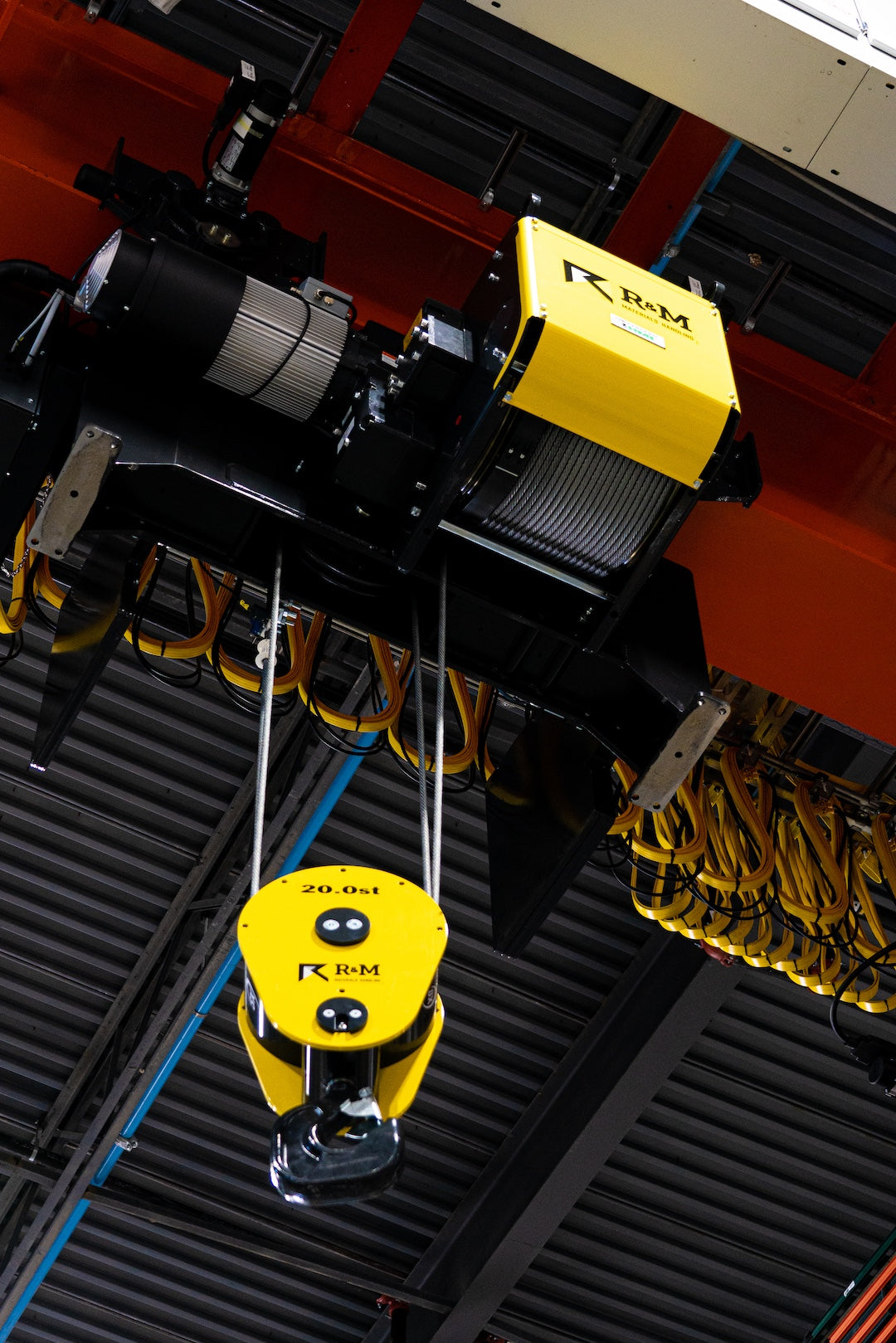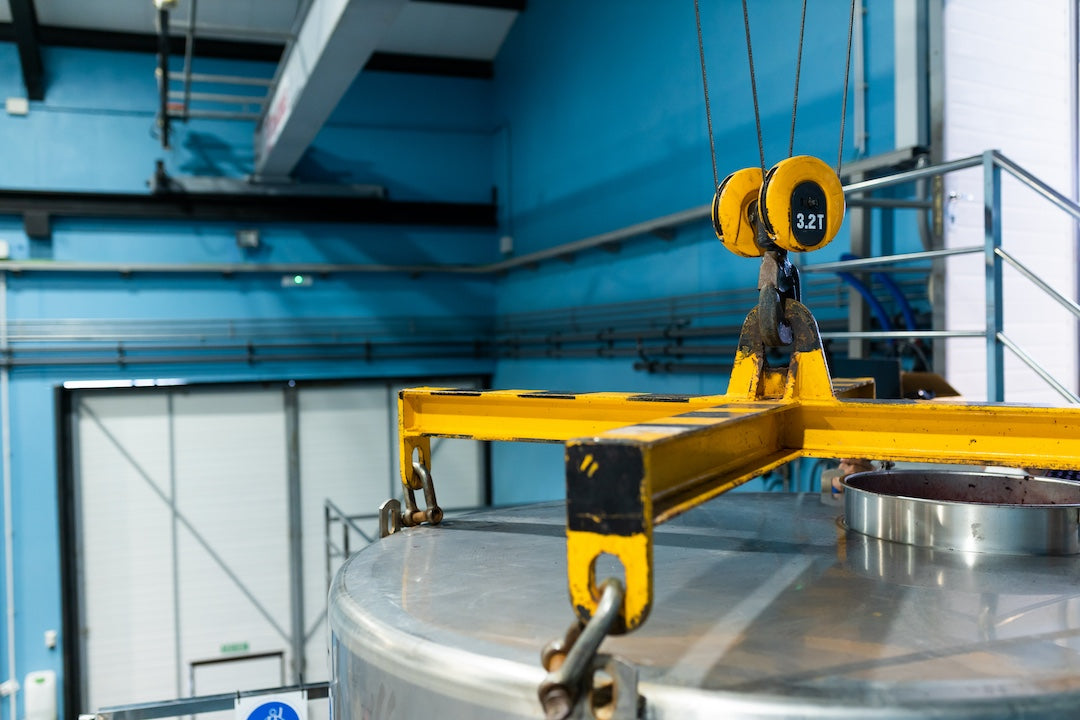Your Cart is Empty

Hook Coverage Area in Overhead Cranes
What is the hook coverage area for crane systems (also called the crane's working span or envelope)? It is the three-dimensional space within which an overhead crane's hook can operate. In practical terms, it encompasses the full range of hook motion along the bridge (width), along the runway (length), and in the vertical lift.
Achieving broad hook coverage is crucial because it determines what portions of a facility the crane can service without repositioning loads by other means. Customers often overlook it.
Good coverage directly translates into higher efficiency and productivity – the crane can reach more work areas, reducing the need for forklifts or other equipment and clearing up floor traffic for a safer, more streamlined operation.
Conversely, inadequate coverage can leave "dead zones" in a building where the crane cannot reach, forcing inefficient workarounds and downtime. In worst cases, operators might be tempted to lift loads outside the crane's intended range (a dangerous side pull), which experts identify as "one of the most common and most dangerous mistakes" in overhead lifting.
"Side pulling isn't just inefficient; it's dangerous. Overhead cranes are engineered to lift vertically—pulling at an angle can seriously compromise structural integrity, risking equipment damage and operator safety. Proper hook coverage planning eliminates the need for side pulling and keeps everyone safer on the floor."
— Nathan Stout, Crane Engineer, HOJ Innovations
Poor initial planning of hook coverage can also lead to expensive retrofits later – upgrading an existing crane's coverage often requires major component replacements and extended downtime.
Thus, understanding and optimizing hook coverage area from the start is critical to safe, productive, and future-ready crane operations.
Table of Contents
- Introduction
- Key Takeaways
- Components of Hook Coverage Area
- X-axis Crane Coverage Area
- Y-axis Crane Coverage Area
- Z-axis Crane Coverage Area
- Design Considerations Affecting Coverage
- Single vs. Double Girder
- Top-Running vs. Under-Running
- Trolley and Hoist Positioning
- Festoon Cables
- Facility Constraints and Solutions
- Future-Proofing and Facility Growth Planning
- Common Misconceptions and Expert Insights
- Conclusion
Key Takeaways
- Hook Coverage Area defines the 3-dimensional operating space of an overhead crane, critical for efficiency and safety.
- Coverage consists of three primary axes:
- X-axis (Lateral Reach): Side-to-side travel along the crane’s bridge.
- Y-axis (End-to-End Travel): Longitudinal movement along the runway length.
- Z-axis (Vertical Lift): Vertical range between floor and ceiling clearances.
- Design choices significantly impact coverage:
- Double-girder cranes provide greater vertical lift than single-girder cranes.
- Top-running cranes offer higher lift capacity, whereas under-running cranes maximize lateral and end coverage.
- Optimal trolley and hoist positioning, as well as cable management (e.g., using energy chains instead of festoons), maximize coverage.
- Facility constraints (walls, columns, ceilings) should be analyzed early to optimize crane placement and hook coverage.
- Planning ahead for future facility changes or expansions prevents costly retrofits later.
- Common misconceptions include believing coverage adjustments are simple post-installation and assuming bigger cranes automatically provide more coverage—both can be misleading.
- Early collaboration with crane specialists like HOJ Innovations ensures optimal coverage, improving safety, efficiency, and adaptability.
Components of Hook Coverage Area
An overhead bridge crane provides hook movement in three axes (X, Y, and Z) covering a volume of space. Each axis contributes to the overall coverage area:
X-axis Crane Coverage Area
X-axis (hook travel width): This is the hook's movement side-to-side along the bridge girder via the trolley. The maximum X-span is essentially the crane's bridge span, but the usable lateral reach is less due to the required clearances at each end.
For example, an overhead crane spanning 10 meters might actually provide about 9 meters of hook reach, leaving a small gap at each side. Physical factors like the trolley width, end truck size, and any overhanging festoon cables determine how close the hook can approach the runway rails or side walls. Designs such as underhung cranes allow the trolley to reach almost the very end of the beam (often within a 2-inch safety clearance), whereas top-running cranes or those with larger trolleys may stop short of the absolute end.
Using compact components can improve lateral coverage – for instance, shorter end carriages and narrower hoist bodies (e.g. a chain hoist versus a bulkier wire rope hoist) can increase the hook's side reach by reducing the "dead" space needed at the girder ends.
No matter the design, OSHA regulations mandate a minimum2-inch lateral clearancebetween any moving crane part and building obstructions, so the crane's lateral reach must be planned with these safety margins in mind.
Y-axis Crane Coverage Area
Y-axis (hook travel length): This axis covers the crane's movement down the length of the building (along the runways).
The theoretical Y coverage is the crane runway's length, but the practical hook reach is a bit shorter because the bridge cannot slam into the end stops. At the runway ends, aminimum 3-inch overhead and 2-inch end clearance is required.
Thus, a crane with an 18-meter runway might have an effective hook travel of roughly 17 meters or a little more. The distance from the end of the runway to the hook's farthest point is known as theend approach. A smaller end approach distance (meaning the hook can get closer to the runway's end) yields a larger coverage area.
High-quality crane designs optimize this by minimizing the front bumper-to-hook distance.
Z-axis Crane coverage Area
Z-axis (hook travel height) refers to vertical hook coverage or how high and low the hook can go – from the floor (or lowest pick-up point) up to its highest lifted position. The vertical coverage is determined by the hoist's lifting height and the crane's headroom design.
Lift height is defined as the distance from the floor to the saddle of the hook at its top position. An overhead crane typically provides nearly full floor-to-ceiling service, but there must be enough headroom so the hook block and load clear the bridge girders and any roof obstructions.
Vertical coverage isn't just about height; one should also consider how low the hook needs to go (for example, into a pit or below floor grade, if required) and ensure the hoist has sufficient rope/chain length for that range.
Design Considerations Affecting Coverage
Crane design choices greatly influence the maximum hook coverage that is attainable. Three major design aspects are the crane's girder configuration, the running mode (top or under-running), and the arrangement of the hoist and trolley. Each involves trade-offs in coverage:

Single vs. Double Girder
The number of bridge girders impacts both vertical and horizontal reach. A double-girder cranemounts the hoist on top of or between two girders, whichimproves vertical coverage by allowing the hook to rise higher (closer to the ceiling).
However, the extra girder willreduce horizontal coverage at the extremes.
Industry guidance notes that double-girder overhead cranes usually have a smaller hook approach distance than comparable single girder cranes on both the trolley travel (bridge span ends) and the bridge travel (runway ends).
In other words, a single-girder design might let the hook get slightly closer to the walls or end stops than a double girder designs would. This is because double-girder trolleys and their support structure can require more clearance.
The takeaway is that while double girder cranes excel in lift height and heavy load capacity, a single-girder crane can provide a few extra inches of reach at the edges. Engineers must balance these factors based on which dimension (height vs. span coverage) is more critical for the application.

Top-Running vs. Under-Running
The way a crane travels on its runway also affects coverage.Top-running cranes ride on rails atop a runway beam, whereasunder-running (underhung) cranes are suspended from the bottom flange of the runway. A top-running crane generally allows greater hook height (especially in a double-girder, top-running configuration, which offers the maximum lift for a given building height).
By riding on top, it also accommodates very heavy loads and wide spans. Underhung cranes, on the other hand, have distinct coverage advantages: since the bridge is beneath the tracks, the hoist can often approach the runway end columns more closely, maximizing the end approach on the bridge.
In fact, an underhung single-girder crane's trolley can typically travel to within only a couple inches of the end of the bridge, as required by OSHA clearance, effectively utilizing the full span minus 2″.
Under-running systems also enable creative coverage solutions likeinterlocking runwaysand curved tracks (e.g. transferring a hoist from one bay to another) that a top-runner cannot do. The downside is that underhung cranes usually have lower capacity limits and slightly less stability; they are ideal for lighter loads (often under ~15–20 tons).
In summary, choose top-running for heavy-duty and high-clearance needs, and consider under-running for lighter duty where maximizing coverage area (including around columns or multiple bay layouts) is a priority.
Trolley and Hoist Positioning
The configuration and placement of the hoist and trolley components can create significantcoverage trade-offs.
Key factors include the girder height, trolley length, and the lifting medium (chain vs. wire rope) and power delivery method. A large trolley or bulky hoist will reduce how close the hook can get to a wall or the end of a runway, due to a bigger "C-dimension" (the distance from the hook to the trolley wheels).
Crane designers seek to minimize these dimensions. For example, some low-headroom hoists are specifically designed to be compact so the hook's approach distance (often called thehook-to-wall dimension) is as small as possible.
Festoon Cables
Festoon cables (looped power cables on a trolley system) can also limit hook approach on one side: as the trolley nears the end, the stacked festoon trolleys can block further travel, cutting off a few feet of potential coverage.

One solution is to use aconductor bar or energy chain system instead of traditional festooning. By running a slim power bar along the runway or using an enclosed energy chain, the "stack-up" of cable trolleys is eliminated, allowing the hoist to approach much closer to the end.
In fact, modern crane packages often integrate such innovations –R&M'sNRGmaster and similar designs by others use flat power bars to maximize hook approach on the cable side of the crane.
Another consideration is whether the hoist is center-mounted or side-mounted on the trolley. An off-center hoist might have different approach distances on each side of the bridge. Generally, an optimized crane will usesymmetrical, compact trolleys and tailored hoist designs so that every inch of span and runway length contributes to the working coverage.
Collaboration with the crane manufacturer during design is key – by selecting the right hoist, trolley, and power supply method, you can often gain extra coverage that would be lost with a generic configuration.
Specialists like HOJ Innovations provide expert insights and tailored crane systems to maximize hook coverage within your unique facility constraints.
Facility Constraints and Solutions
Every building presents unique constraints that can affect a crane's hook coverage. Understanding these facility factors and planning solutions around them is essential:
-
Site Layout, Walls, and Columns: A thorough site analysis should map out the placement of walls, support columns, mezzanines, machinery, and any other obstructions relative to the crane's travel path. The crane's coverage area will always be a bit less than the building's dimensions because of these obstacles.
-
Ceiling Height and Headroom: The building's ceiling height and any overhead structures (beams, trusses, HVAC ducts, lights, sprinklers) will constrain vertical coverage and possibly horizontal movement.
-
Floor Obstacles and Pits: While overhead cranes mostly eliminate floor obstructions, take note of any floor-level features like assembly pits, open storage vaults, or machinery that protrudes upward. The hook coverage analysis should include how the hook will lower into any pits or between machinery if required, and if the crane's approach is limited by these features. In some cases, additional equipment like a smaller jib crane or hoist might be installed to handle areas the main crane cannot directly service.
-
Regulatory Compliance and Optimization: EnsuringOSHA compliance while optimizing coverage can be a balancing act. As noted, OSHA 29 CFR 1910.179 requires specific clearances. It's important to design the crane runway and building interface to meet these clearances from day one.
Future-Proofing and Facility Growth Planning
Maximizing coverage isn't only about the immediate layout – it's also about anticipating future needs. A common mistake is underestimating how much area or lifting flexibility you might need down the line.
To avoid this, consider any potential facility expansions, new production lines, or changes in workflow that could require the crane to service additional areas or different lifting points. It is far easier and cost-effective to plan for extra hook coverage upfront than to modify a crane later.
The goal is a crane system that meets today's coverage requirements and can adapt to tomorrow's challenges without major rework.
Common Misconceptions and Expert Insights
Even seasoned facility managers can hold misconceptions about crane coverage. Here we address a few common myths and share insights from industry experts:
-
Misconception #1:"If our crane doesn't reach a spot, we can always modify it or add to it later."
-
Reality: Retrofitting an overhead crane for greater coverage is often complex and costly. It can require replacing major components, relocating runways, or upgrading electrics – all of which lead to significant downtime.
-
Misconception #2:"A bigger or more powerful crane will automatically cover more area."
-
Reality: Higher capacity or more complex cranes (e.g. double-girder, heavy-duty models) do not inherently guarantee better coverage than simpler cranes. In fact, a double-girder crane can haveless horizontal hook approach than a single-girder crane of the same span. This is a subtle design trade-off – the additional structure needed for big cranes can increase clearance distances. As a result, if you swap a single-girder crane for a double-girder without adjusting dimensions, the new crane's hook might not reach as far to the building edges. Evaluate coverage independently of capacity: choose the crane type that meets your load needsand check the stated hook approaches on all sides. Don't assume "bigger covers more" without verification.
Conclusion
In summary,hook coverage area defines the reachable working area of an overhead crane across all three axes – and it is a make-or-break factor for efficient material handling. We have seen how coverage is determined by the crane's span (X-axis reach), runway travel (Y-axis length), and lift height (Z-axis range), and how each of these can be maximized through thoughtful design and component choices to obtain superior clearance.

Key design considerations such as using single vs. double girders, top-running vs. under-running configurations, and minimizing approach distances have a direct impact on how much of your facility the crane can serve. By thoroughly analyzing facility constraints – from wall clearance and column placement to ceiling height and OSHA safety gaps – you can tailor the crane system to cover the intended workspace completely while adhering to regulations.
The benefits of achieving optimal hook coverage are substantial. It leads tofaster workflow and higher productivity, as the crane can pick up and deliver loads exactly where needed without interim steps or repositioning.
It enhancessafety, by eliminating risky practices and reducing floor clutter (since one overhead system can replace multiple other handling devices). And it provides acompetitive operational advantage – facilities with well-designed crane coverage can handle larger or more complex assemblies, turn jobs around quicker, and scale up operations with minimal disruption.
In a landscape where efficiency and flexibility drive profitability, investing in greater hook coverage means your overhead crane truly "covers" your needs, unlocking the full potential of your workspace. By treating hook coverage as a top priority from design through operation, facility managers and engineers can ensure their overhead crane remains a powerful productivity asset and a cornerstone of safe, lean, and adaptive operations for years to come.
Ensure your crane delivers optimal hook coverage from day one. HOJ Innovations provides tailored crane solutions designed around your facility’s precise needs—maximizing efficiency, improving safety, and setting your operation up for future growth.
Connect with HOJ today to unlock the full potential of your overhead crane.








